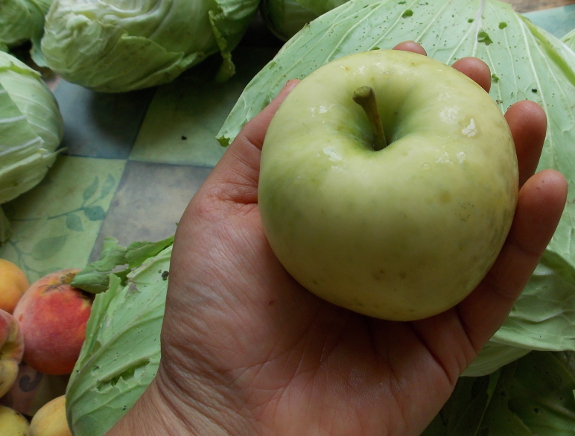
Early summer apples for Virginia

If you aren't buying
your apples from a store and are instead keeping them in a root
cellar, your storage apples are going to give out by February or
so, leaving you with a hankering for crisp pomes in early
summer. The first apples might ripen up as late as July (or
even August) if you live in New England (or have a particularly
cool, rainy year like this one), but around here they're often
called "June apples" and tend to come on in late June. June
apples have a less intense flavor than later apples and they tend
to keep only a few days once they're ripe, so you wouldn't want to
plan a whole orchard around them, but one or two trees in your
garden are a summer treat.
Yellow Transparent is
the standby June apple in our area, and we've got a dwarf in our high-density planting and a
semi-dwarf in the forest garden. Thursday, Mark and I tasted
the first ripe sample (from the high-density planting) and gave it
top marks. Yellow Transparent (also known as White
Transparent, Russian Transparent, and Grand Sultan) wouldn't stand
up against really flavorful fall apples, but it beats the kind you
get in the store at this time of year and makes an excellent sauce
and pie. The trick with Yellow Transparent is to wait until
the flesh turns very yellow-green, and then to pick the fruit
right away before it gets mealy.
Tim Hensley, the source of several of our apples, posted the embedded youtube video this week
to highlight four other early apples he recommends (along with the
Yellow Transparent, which is the most popular and largest).
Henry Clay (a very small, ribbed apple introduced by Starks Bros.)
won his taste test, although the Red Astrachan was also noted to
be richly flavored. Lodi is an offspring of Yellow
Transparent that is more resistant to fire blight, but Hensley
notes that most people prefer the taste and texture of the parent
apple. Finally, Early Harvest is the very earliest apple he
reviewed, with apples sometimes ripening as soon as June 1, and
being sweeter than the other early apples.
We may try another
early apple in our high density planting next year since it looks
like the Pristine (a new, hybrid early apple) can't take the fungi
in our climate. The trick will be determining which of these
early apples is as disease resistant as
the Early Transparent, which seems to thrive despite our cedar
apple rust and general dampness.
Is there a preferred early-apple variety in your neck of the
woods? When do the first apples near you ripen? I'd be
curious to hear if Yellow Transparent is a standby in other areas,
or just around here.
Want more in-depth information? Browse through our books.
Or explore more posts by date or by subject.
About us: Anna Hess and Mark Hamilton spent over a decade living self-sufficiently in the mountains of Virginia before moving north to start over from scratch in the foothills of Ohio. They've experimented with permaculture, no-till gardening, trailersteading, home-based microbusinesses and much more, writing about their adventures in both blogs and books.
Want to be notified when new comments are posted on this page? Click on the RSS button after you add a comment to subscribe to the comment feed, or simply check the box beside "email replies to me" while writing your comment.

I've had Red Astrachan (at my grandmother's, and, I think, one of the trees at the Old House at the Store), and have really liked them for a summer apple. Depending on how long it takes to cut up apples for sauce, and the color skins, you may have pinkish or brownish (or even green-yellow) sauce. Never use sweetening in sauce, not needed!!
I wonder what that apple was, on the way to Abrams Falls, a fall apple, maybe a Mann apple?
We always had a lodi tree growing up. We never ate them off the tree though, and they would crack within a week of being picked. They were a staple though, for freezer apple sauce. We never made summer apple pies because we were always inundated around that time with late cherries, raspberries, and early peaches.
I would like to get my hands on some lodi to try out their pectin level and make some apple jelly. I LOVE pepper jelly and understand that a neutral apple (or crabapple) jelly makes a good base. That would be an interesting additional use for early lodi's, as we really only eat so much apple sauce anymore. If that worked, then it might be worth trying to slip a lodi into the orchard. I am trying to plan the next round of fruit tree acquisitions (and I have three apple rootstocks in need of grafting/topwork and two pears.) Lodi has been one variety that I've been going back and forth with.
I just got back from visiting my parents and grandparents in Eastern Washington. I came home with apricots, zucchini, new potatoes, early peaches, raspberries, and last year's venison.